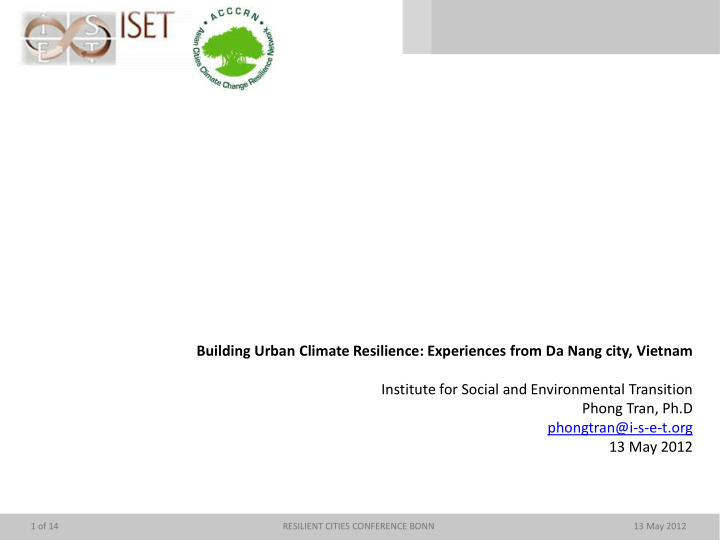



Building Urban Climate Resilience: Experiences from Da Nang city, Vietnam Institute for Social and Environmental Transition Phong Tran, Ph.D phongtran@i-s-e-t.org 13 May 2012 1 of 14 RESILIENT CITIES CONFERENCE BONN 13 May 2012
Why Urban Climate Resilience Approach? How do we plan for climate resilience in Da Nang city? Need an approach that clarifies complex sources of urban vulnerability Must be simple enough for local practitioners to apply in context This approach applied in 10 cities as part of Asian Cities Climate Change Resilience Network (ACCCRN) funded by Rockefeller Foundation 2 of 14 RESILIENT CITIES CONFERENCE BONN 13 May 2012
Resilience? The capability of a system faced with shocks or stresses to maintain or quickly restore its function Includes the ability to: LEARN from and adapt to experience – i.e. to change strategies or structure of the system RESPOND to unexpected events 3 of 14 RESILIENT CITIES CONFERENCE BONN 13 May 2012
Urban Climate Resilience Planning Framework Change Local Scientific Agents knowledge knowledge 4 of 14 RESILIENT CITIES CONFERENCE BONN 13 May 2012
Urban Climate resilience planning process in Da Nang SLDs Vulnerability Assessment Sector studies and Pilots Resilience Planning Engagement Climate context Detailed study Develop and impact of major issues strategy for Shared Learning action Vulnerable Experience with Multiple groups and small scale Select priorities stakeholders sectors activities Assemble complementary activities Science and Local Knowledge 5 of 14 RESILIENT CITIES CONFERENCE BONN 13 May 2012
Shared Learning Dialogue Process 6 of 14 RESILIENT CITIES CONFERENCE BONN 13 May 2012
Key characteristics of urban resilience planning process in Da Nang Led by local governments Engage multiple departments and stakeholders in project development and implementation Build capacity, share and learn within and among cities Collaborate in work plan development Combine traditional and scientific knowledge through change agents 7 of 14 RESILIENT CITIES CONFERENCE BONN 13 May 2012
Climate Change Coordination Office Strengthen capacity of CCCO Strengthen the participation of vulnerable communities in the decision making process Assemble and provide access to data required to assess future climate impacts in relation to urban development plans Coordinate the climate change resilience analysis Coordinate climate change planning and programming at the city level 8 of 14 RESILIENT CITIES CONFERENCE BONN 13 May 2012
Storm Resistant Housing Program Establish Revolving Loan Fund for Storm Resistant Housing Build capacity among program participants and community members Train local builders to design, and construct clime resistant housing Demonstrate a successful and scalable housing credit scheme 9 of 14 RESILIENT CITIES CONFERENCE BONN 13 May 2012
Integrative Education for Urban Climate Resilience To develop integrative education models for urban climate resilience education To develop guidelines for integrating urban climate resilience education into school curriculum To enhance capacity of teachers To replicate and scale up the integrative urban climate resilience education models To promote replication of successful practices in other parts of the country 10 of 14 RESILIENT CITIES CONFERENCE BONN 13 May 2012
Hydrological modeling for urban planning project Develop a database on climate change impacts on socio economic development and urban planning Develop hydraulic model of Da Nang city Use the paired models as a basis for urban H-H calculations and other projections Prepare a multi agency guidance document regarding urban development under future climate conditions Increase awareness of both the potential impacts of climate change on urban development 11 of 14 RESILIENT CITIES CONFERENCE BONN 13 May 2012
Key challenges Top down planning commonly practiced Extreme vulnerability to CC and rapid urbanization Lack of coordination Resilience planning components new for local people Traditional “predict then act” approach vs. resilience approach of “learn from and adapt to unexpected events” 12 of 14 RESILIENT CITIES CONFERENCE BONN 13 May 2012
Way forwards City resilience plan Infrastructure, ecosystems, capacity, institutions No-regret measures Increase awareness and skills New planning 13 of 14 RESILIENT CITIES CONFERENCE BONN 13 May 2012
Thank you for your attention. 14 of 14 RESILIENT CITIES CONFERENCE BONN 13 May 2012
Recommend
More recommend